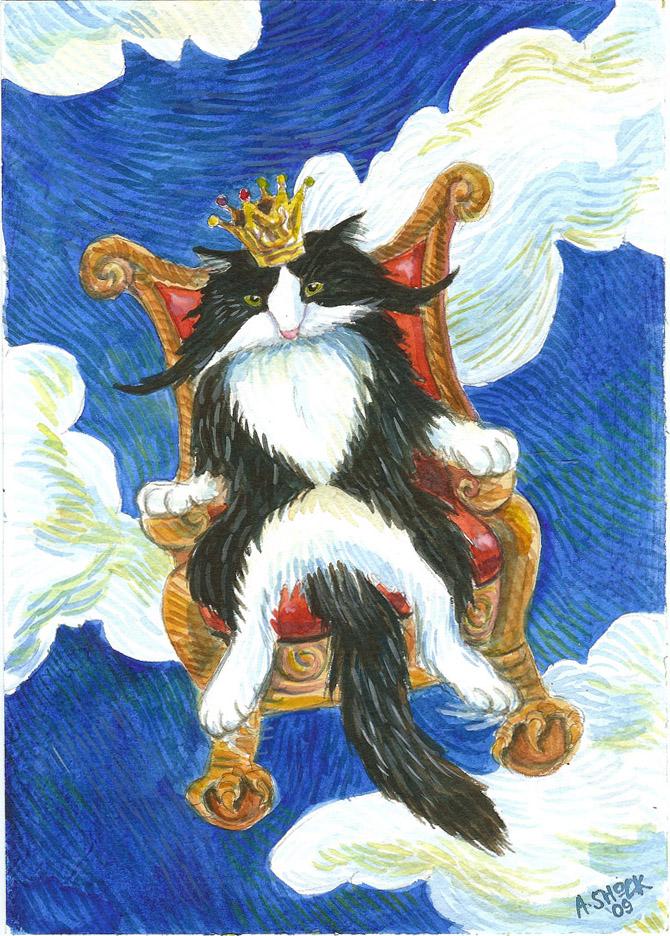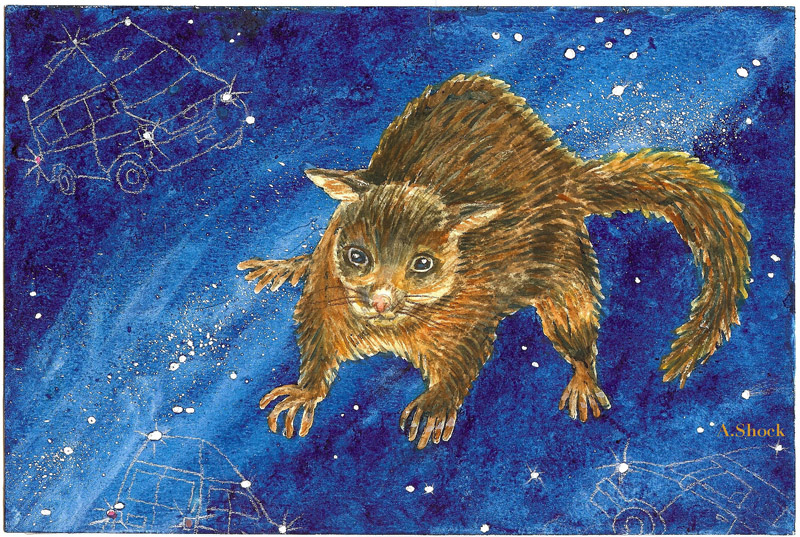Festival of Desert Doves: the Other Collared Dove
The Eurasian Collared Dove (Streptopelia decaocto) has an agenda well-befitting a Columbid: “Must Colonize New World.”
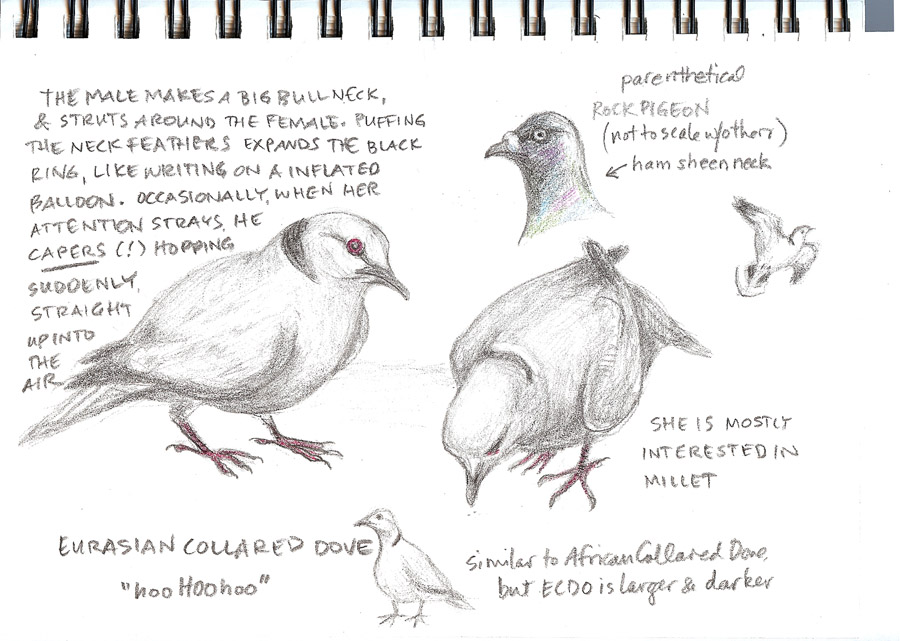 Actually, it started before that, and a lot farther east: a native of central Asia, the Collared Dove had populated Europe as far west as Great Britain by the 1950s. By the early ’80s, a population had taken hold in Florida, likely coming from the Bahamas where they also had been introduced (or escaped captivity) in the 1970s. From there, the large doves filled the southeastern US, and have been spreading inexorably west and north. The first documented report of the species in the state of Arizona was in Eager, AZ, on March 6, 2000, and they were regularly sighted in Maricopa County by the end of the same year.
Actually, it started before that, and a lot farther east: a native of central Asia, the Collared Dove had populated Europe as far west as Great Britain by the 1950s. By the early ’80s, a population had taken hold in Florida, likely coming from the Bahamas where they also had been introduced (or escaped captivity) in the 1970s. From there, the large doves filled the southeastern US, and have been spreading inexorably west and north. The first documented report of the species in the state of Arizona was in Eager, AZ, on March 6, 2000, and they were regularly sighted in Maricopa County by the end of the same year.
As mentioned in a previous post, they’re quite similar to the African Collared Dove (which used to be called the Ringed Turtle Dove), but they’re bigger, and a darker beige, and have different vocalizations. In the Phoenix area and over much of Arizona, Eurasian Collared Doves have become quite numerous — on some days I would ungenerously call them a pest in our yard — and a few theories exist as to why they’ve spread so rapidly. One is that they fill a niche left empty by the extinction of the Passenger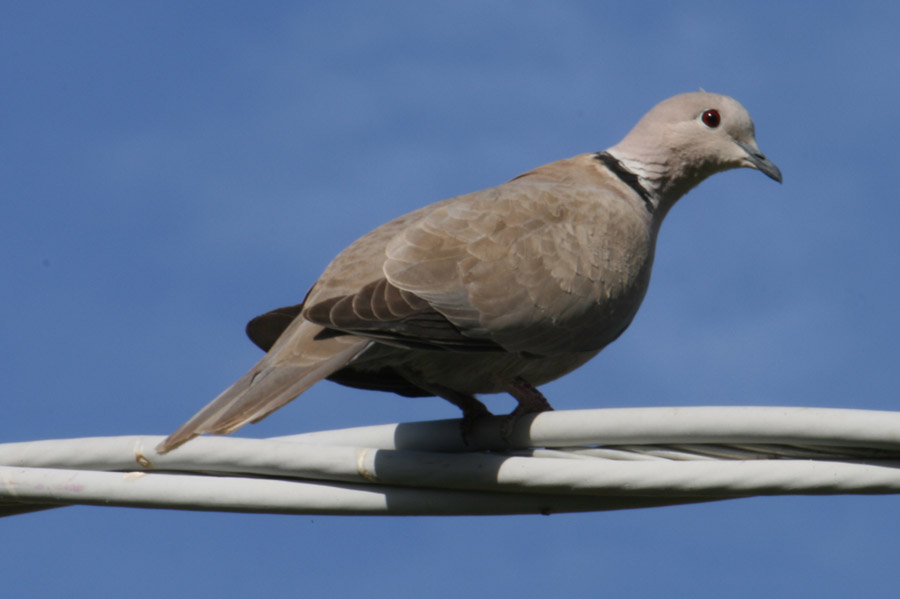 Pigeon (Perhaps in the Northeast U.S., but I’m not so sure that applies to the desert regions?).
Pigeon (Perhaps in the Northeast U.S., but I’m not so sure that applies to the desert regions?).
Like the African Collared Doves, they show a disturbing willingness to become tame, and quickly learn to fly down to empty feeders when they see someone coming out with a bag of birdseed. I’ve caught them lurking on top of my studio — their toenails clicking on the roof, their pink foot skin glowing hazily through the translucent plexi panels — as if lobbying for the filling of neglected feeders in a kind of inexorable zombie-like way. They’re hard to miss since their arrival is a dry noisy wing flapping, the thump of a hard landing of a big heavily-wingloaded airship, and the inevitable repetitive hoo-ing and gibbering that follows.
(Images: pencil sketchbook drawing and photo by A.Shock)
In The Cat’s Own Dream…
…he is Hector Roi:
“Hector Roi” watercolor and colored pencil, 7×10″ by A. Shock 2009
Raccoon recount
Also, on an unrelated but more naturalistic topic, a reassessment of the local raccoon population has been necessary. The night after the Hair Hen post, mama raccoon showed up with FOUR kits. It was clear that this could not be yet another litter, and also that there were not two Hairhens: it was one female who was bringing out cubs one or two at a time, as they became ready to join her nightly foragings. So, as it stands now, the count is ONE hairhen and FOUR kits. Last night they were preening and nipping each other in the fork of the big Palo Verde, making endearing snarling sounds. Too dark for photos, unfortunately.
Meet the Hair Hen…
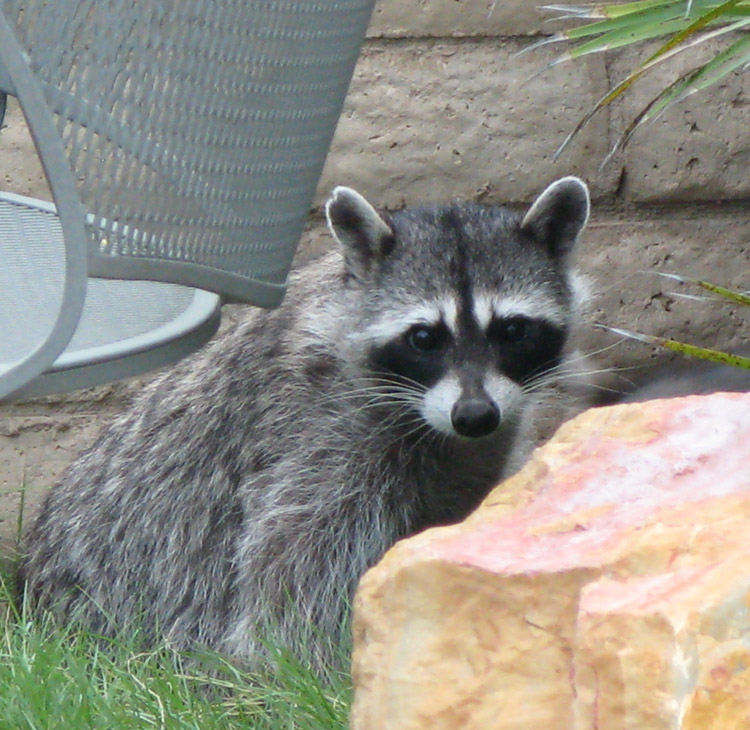 This is the Hair Hen. Actually, there are two; we call them both the Hair Hen because we used to not be able to tell them apart. Now we can: one has two kits, the other has three.
This is the Hair Hen. Actually, there are two; we call them both the Hair Hen because we used to not be able to tell them apart. Now we can: one has two kits, the other has three.
This is a picture of the three-kit Hair Hen. She lives under the Mexican Fan Palm in the back yard, where she spends much of the day. She talks to the kits and keeps them in line with a soft churring purry noise, so we know they’re there even when we can’t see them in the deep thicket of thorny fronds and shaggy trunks.
We’ve been seeing the two-kit hairhen and her brood, but this evening our neighbors called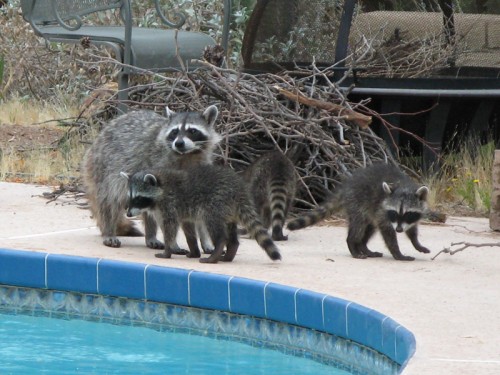 and alerted us to the three-kit hairhen: the furry family was headed our way. Sure enough, a minute later they were strolling along the pool deck, learning how to drink from the pool by putting their paws on the plaster under the tile and leaning way over. (Hey! be careful — no lifeguard on duty…)
and alerted us to the three-kit hairhen: the furry family was headed our way. Sure enough, a minute later they were strolling along the pool deck, learning how to drink from the pool by putting their paws on the plaster under the tile and leaning way over. (Hey! be careful — no lifeguard on duty…)
This may or may not be the same hairhen who threw three kits last season; we can’t know for sure. (If she is the same one, she now has a chip in the tip of her right ear).
How many raccoons is too many?
(Photos A. Shock)
My Hoodia Stinketh
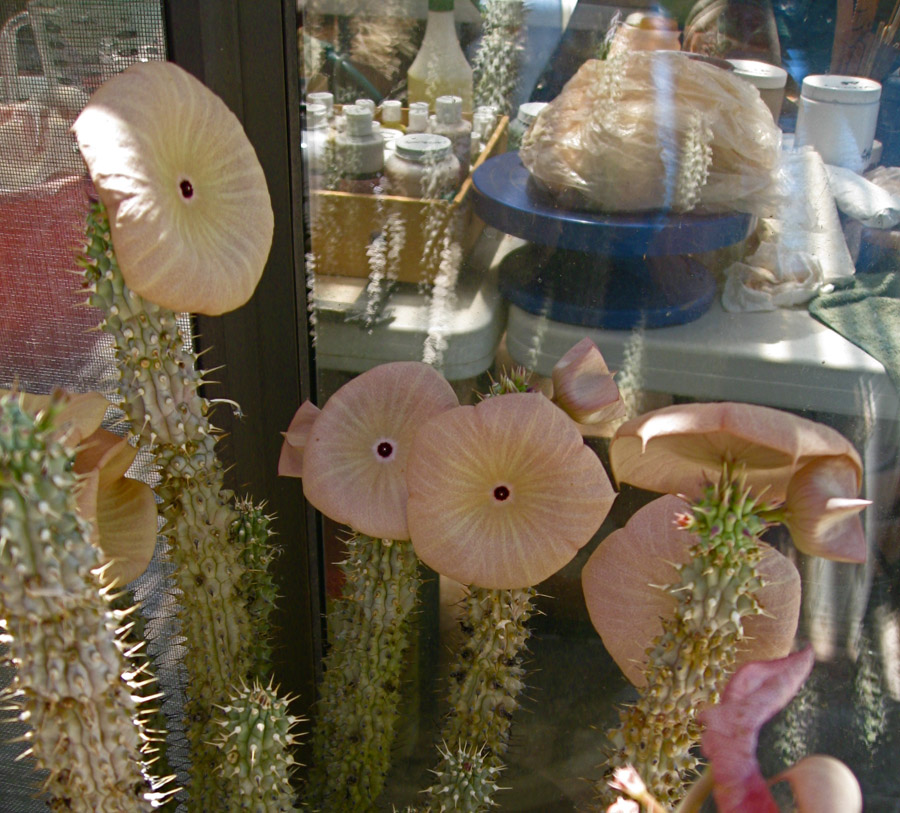 For a few days I’ve been whiffing a whiff, which has caused me to search for the dead mouse in my studio.
For a few days I’ve been whiffing a whiff, which has caused me to search for the dead mouse in my studio.
Then, I noticed the Hoodia is blooming. It sits on the shelves right outside the work tables. That window is always open, being the draw-source for the swamp cooler air. So the stinkitude of the big radar-shaped flowers was being propelled directly into my work area. Here’s a picture of the offending vegetable; you can see glaze bottles and a banding wheel through the glass behind it.
The genus Hoodia is comprised of cactus-like stem-succulents whose flowers are pollinated by flies. To attract flies, it is desirable to smell like carrion. So like their cousins Huernias and Stapelias, Hoodias put out flat flowers the color of puffy, pus-streaked dead flesh with a blood-dark target center. They smell convincingly of rotting meat, especially in warm weather.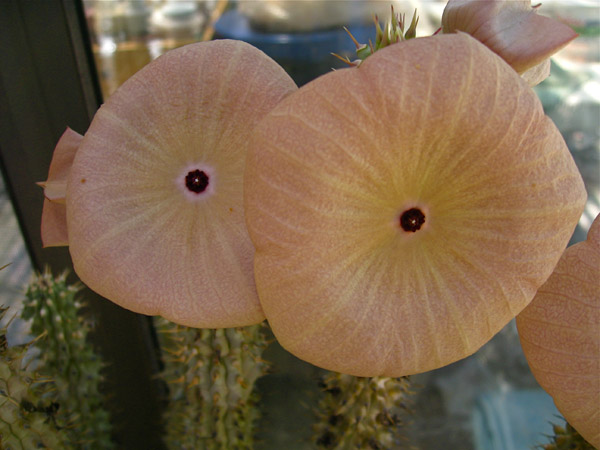
Does it work? Yes; there are a number of flies buzzing inquisitively around the plant all day. And — is it possible? — this morning as I was hanging out laundry to dry, there was a turkey vulture circling low, right over the studio perhaps aiming its pervious nostril at our garden…
This specimen blooms heavily around the middle of June every year, as long as it gets enough water in the growing season. It is labeled Hoodia gordonii, of appetite suppressant fame, it having been observed by ethno-anthropologists that the indigenous people of the Namib use Hoodia to relieve hunger. Hoodia are not cactus at all, but members of the subfamily Asclepiadoideae, and so are related to milkweed.
(Photos A.Shock)
Festival of Desert Doves: African Collared Dove
The desert suburbs of Phoenix are Columbid-rich, that is, there are many species of doves and pigeons. Yesterday I was putting out seed in a neighbor’s gravel drive just before sunset. The area is quite open, and at that time of day it fills with fat, free-loading doves and pigeons who are used to being fed there and then: after only a minute, there were 30 birds chowing down, their heads bobbing up and down rapidly like sewing machine needles, almost all of them Columbids. I counted six species both native and exotic — all the species regularly seen in our neighborhood and most seen regularly in the Phoenix area at this time of year: Mourning dove, White-winged dove, Inca dove, Eurasian Collared Dove, African Collared dove, and Rock Pigeon.
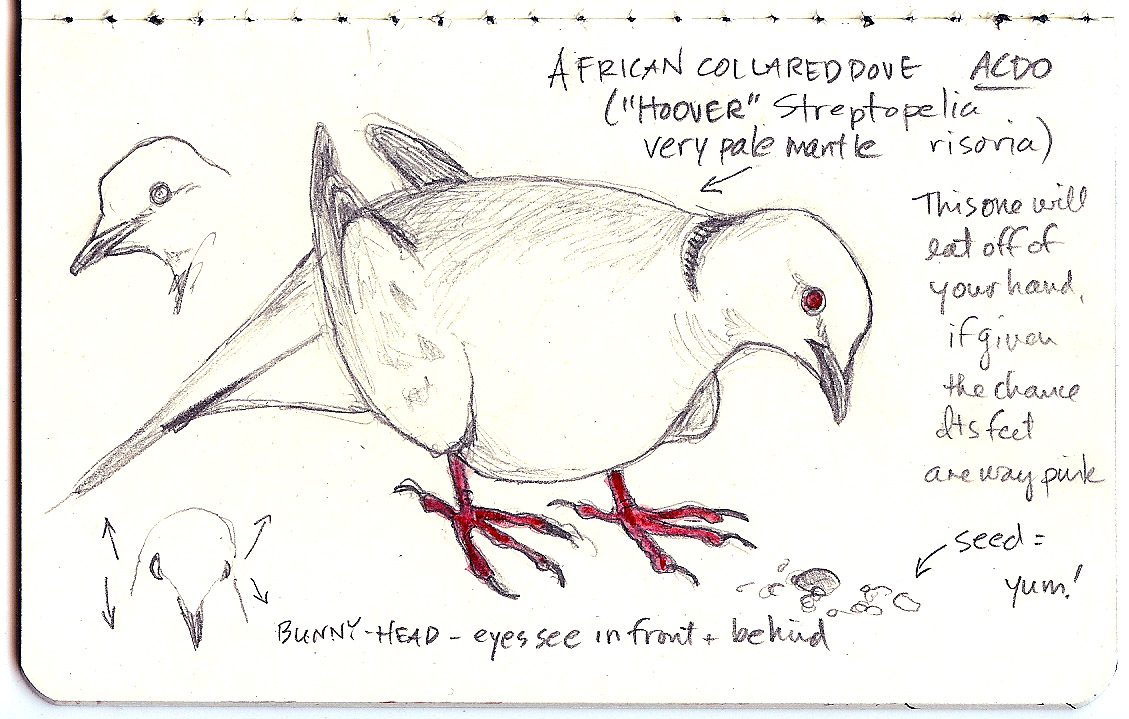 There was only one African Collared dove (Streptopelia roseogrisea). This species, like its close relative the now-abundant Eurasian Collared dove, is an exotic. But unlike the ECDO, which was introduced in one place and then spread itself across the nation, the African Collared dove (or Ringed Turtle dove) was originally released very close to here but hasn’t spread widely, even in the Phoenix area.
There was only one African Collared dove (Streptopelia roseogrisea). This species, like its close relative the now-abundant Eurasian Collared dove, is an exotic. But unlike the ECDO, which was introduced in one place and then spread itself across the nation, the African Collared dove (or Ringed Turtle dove) was originally released very close to here but hasn’t spread widely, even in the Phoenix area.
The plumage of the two exotic doves are somewhat similar: both are beige and have a black crescent on their neck. They can be hard to tell apart, until you get the hang of it. The African is a smaller, paler dove, almost white, with a gentle two-note call that sounds like the chorus from the Rolling Stones’ “Sympathy for the Devil”: “Woo-HOOooo!” The larger Eurasian is slightly darker in plumage and has a hoarse three-note call with the emphasis on the middle note: “hoo-HOO-hoo” which it utters incessantly.
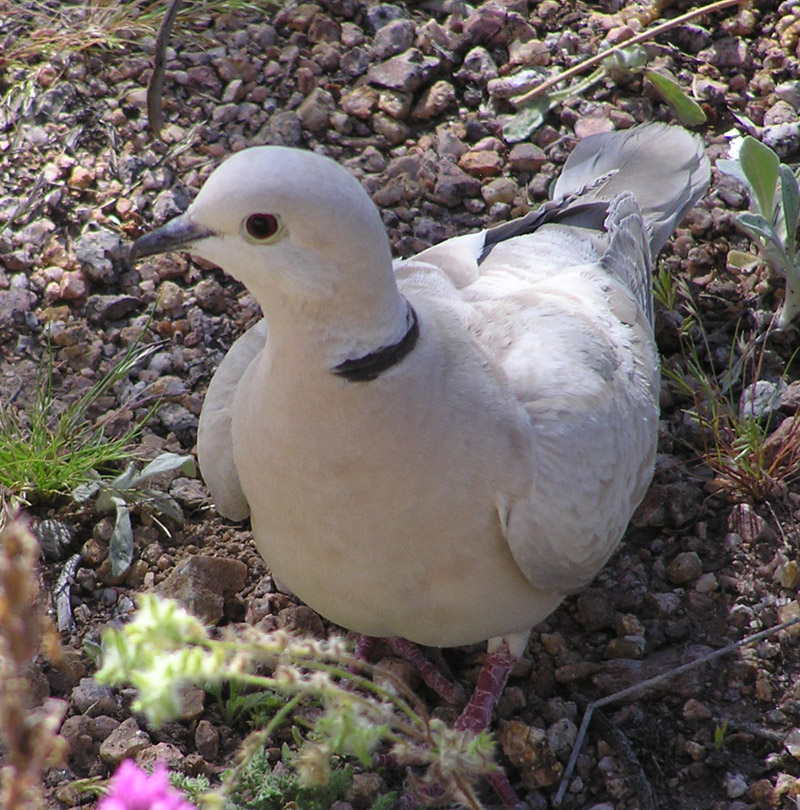 Our neighborhood hosts a small population of the daintier African Collared dove, and one of them spends most of its time mooching in our yard and our neighbor’s yard. Because of its habit of snarfing up seed rapidly, packing it into its crop and then flying off to digest at leisure, we’ve named it Hoover, like the vacuum cleaner. (Hoover used to have a mate, Eureka, but she’s not around these days). These birds are quite “sweet”: by that I mean they are not very afraid of people, unlike the other doves which all have a proper wariness towards humans. They will fly right down and land on the ground at your feet if they think seed is to be had. Not surprisingly given these behavior traits, there has been debate among ornithologists as to how domesticated this species (or variety) of dove is, but currently it’s enjoying full species status.
Our neighborhood hosts a small population of the daintier African Collared dove, and one of them spends most of its time mooching in our yard and our neighbor’s yard. Because of its habit of snarfing up seed rapidly, packing it into its crop and then flying off to digest at leisure, we’ve named it Hoover, like the vacuum cleaner. (Hoover used to have a mate, Eureka, but she’s not around these days). These birds are quite “sweet”: by that I mean they are not very afraid of people, unlike the other doves which all have a proper wariness towards humans. They will fly right down and land on the ground at your feet if they think seed is to be had. Not surprisingly given these behavior traits, there has been debate among ornithologists as to how domesticated this species (or variety) of dove is, but currently it’s enjoying full species status.
(Images of ACDOs: sketchbook pencil sketch and photo, A.Shock.)
Springtime do-over in Sedona (with Bonus Wild Hen nidification)
 We missed some of Spring in the desert this year, so last weekend we went in search of it under the Mogollon Rim: Sunday found us hiking along the West Fork of Oak Creek in Sedona. It’s one of the more popular trails in that popular area, and at times it’s mobbed by clusters of sweaty Phoenicians looking for a quick cool-off up in the oak pine red rock country. But the weather in the desert has been cooler than seasonal, and although we certainly weren’t alone on the path, the trail wasn’t as crowded as we feared.
We missed some of Spring in the desert this year, so last weekend we went in search of it under the Mogollon Rim: Sunday found us hiking along the West Fork of Oak Creek in Sedona. It’s one of the more popular trails in that popular area, and at times it’s mobbed by clusters of sweaty Phoenicians looking for a quick cool-off up in the oak pine red rock country. But the weather in the desert has been cooler than seasonal, and although we certainly weren’t alone on the path, the trail wasn’t as crowded as we feared.
The day couldn’t have been more beautiful — Oak Creek Canyon at that point is a mile high (literally) so it’s still spring up there, with lots of showy color. Both Scarlet and Yellow Monkey Flower (Mimulus cardinalis and guttatus), Golden columbine (Aquilegia chrysantha), and Western spiderwort (Tradescantia occidentalis) were at their peak.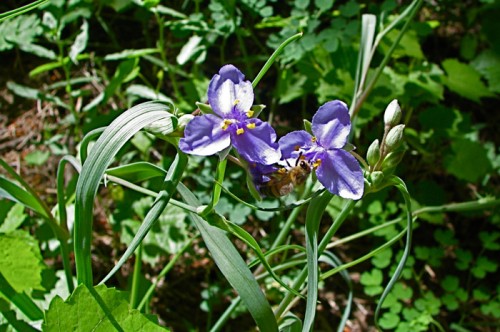 Columbian monkshood (Aconitum columbianum) and Deers-ears (Frasera speciosa) were just beginning, as were the False Solomon’s seal (Smilacina sp). Butterflies abounded — both on flowers and on ammonia-rich heron-wash smears on the gravelly banks — and the air was lively with swallowtails, skippers and sulphurs, and others I don’t know.
Columbian monkshood (Aconitum columbianum) and Deers-ears (Frasera speciosa) were just beginning, as were the False Solomon’s seal (Smilacina sp). Butterflies abounded — both on flowers and on ammonia-rich heron-wash smears on the gravelly banks — and the air was lively with swallowtails, skippers and sulphurs, and others I don’t know.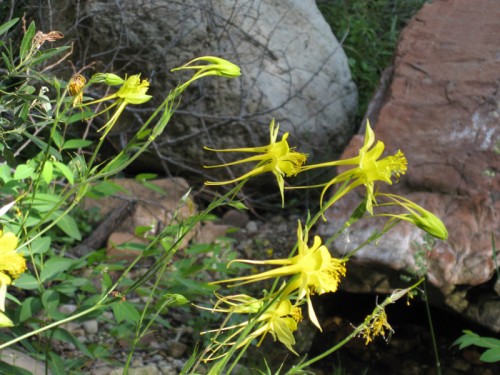
The local birds were lively and showy too, the males singing and holding territory: Lazuli bunting (Passerina amoena), Black-headed grosbeak (Pheucticus melanocephalus), Western tanagers (Piranga ludoviciana), and Red-faced warblers (Cardenlina rubifrons) were among the colorful singers, while Cordilleran flycatchers (Empidonax occidentalis), House wrens (Troglodytes aedon), Plumbeous vireo (Vireo plumbeus) and the ethereal-voiced Hermit thrush (Catharus guttatus) were vocal but plainer of plumage.
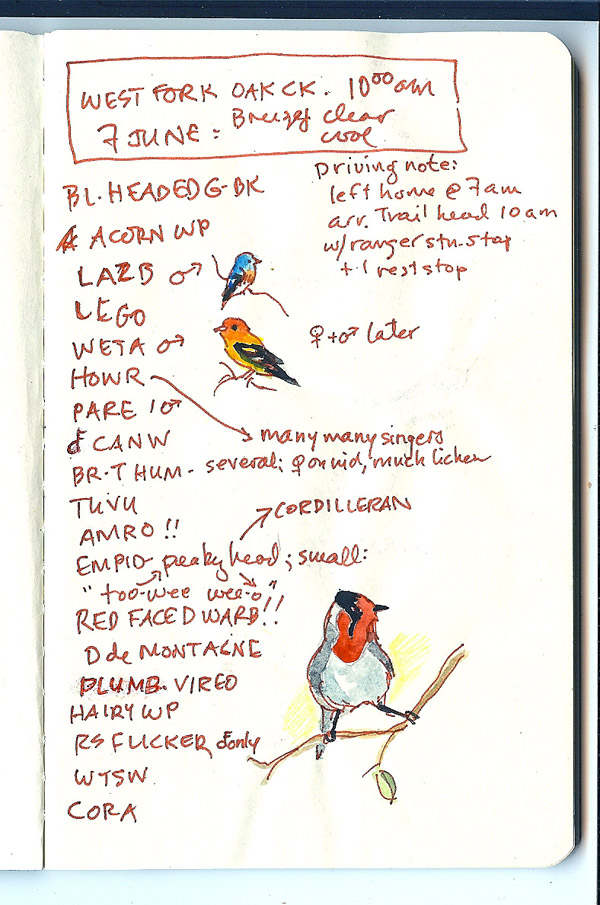 Now, I admire a little brown bird as much as anyone — the House wren is a delight to watch, singing so hard its little barred tail vibrates — but it’s tough to not be swept away by the sight of tiny woodland jewels like Red-faced warblers, who were numerous and singing, or the Painted redstart (Myioborus pictus) who was foraging quietly and intently as if he had nestlings and a mate to feed.
Now, I admire a little brown bird as much as anyone — the House wren is a delight to watch, singing so hard its little barred tail vibrates — but it’s tough to not be swept away by the sight of tiny woodland jewels like Red-faced warblers, who were numerous and singing, or the Painted redstart (Myioborus pictus) who was foraging quietly and intently as if he had nestlings and a mate to feed.
To the right is a page of the day’s birdlist, sketchily illustrated on the fly with really tiny thumbnails of a couple of the brighter species. (I’ve been honing down a back-packing sized watercolor kit, and it’s coming along well, although I haven’t yet gotten the paints pared down to an Altoids-tin, since Jerry’s Artarama is still out of empty half-pans). The bird-list is small-scale, too — in a Moleskine journal just 3.5×5.5″.
The Broad-tailed hummingbirds (Selasphorus platycercus) were zizzing around fussily, 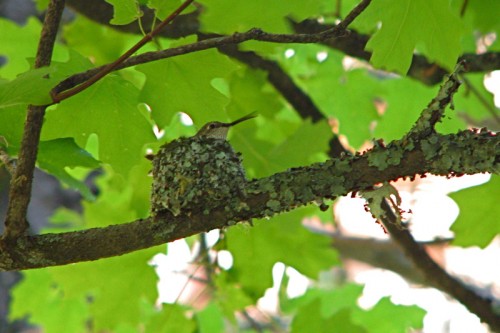 sometimes more easily heard than seen, but we lucked into looking up at just the right time to see this Hen settle onto her nest on a bough directly over the trail. Check out her clever lichen-camo, and how it blends right down into the lichen-covered Big-toothed maple branch!
sometimes more easily heard than seen, but we lucked into looking up at just the right time to see this Hen settle onto her nest on a bough directly over the trail. Check out her clever lichen-camo, and how it blends right down into the lichen-covered Big-toothed maple branch!
The Phoenix-Sedona round trip with an eight-mile hike in the middle makes for one long day, but even so we came back refreshed and renewed, glad to have a cooler option when the desert is too hot to hike. Graduated seasons are one of the nicest things about living in a state with delightfully drastic topography.
(Photos from top to bottom: red rock overhang, West Fork of Oak Creek, A.Shock; Spiderwort being pollinated by Eurobee, E.Shock; Golden columbine dragon-heads, A.Shock; illustrated bird-list, A.Shock; Broad-tailed hummer hen on nest, E.Shock)
The (retail) plundering of the continents…
…results in Kiwi-“flavoured” tea-towels.
Some people search out exotic specialties and luxuries when they travel, studying the ethnographic crafts and traditional handworks unique to the region. I admire this, but don’t seem to be able to accomplish it for my own trips. I want small, light, unbreakable, useful, evocative, and cheap I mean AFFORDABLE. So, I often come back with tea-towels.
Here’s the lot from the recent NZ jaunt, heavily skewed toward the delightful kiwi bird, whose image is favored by native Kiwis and tourists alike.*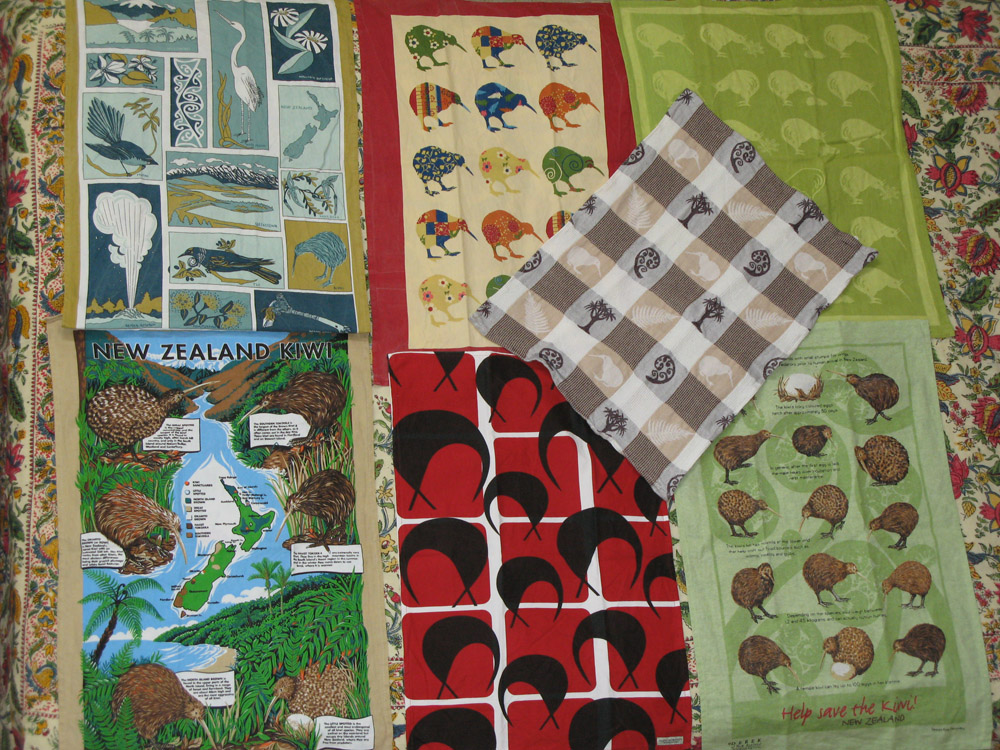
Note that the Kiwi-images go from pared down black-and-red graphics to clunky four-color screens, woven jaquard to printed; all delightful. Favorite? Hmmm… hard to choose: is it the iconographically egalitarian one with many of the delights of NZ (geysers, plants, Maori artefacts, and of course Kiwi birds)? Or perhaps the educational design which, although fact-filled conflates the concept of species and Breed, 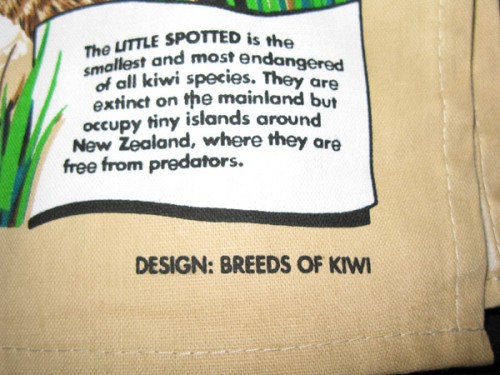 calling itself “Breeds of Kiwi”, as if Kiwi birds, like sheep and cattle, were engineered in size and type by and for us humans? Or, the patchwork Kiwi, or the Kiwi and cabbage trees? Hard to say which is most satisfying, the most Kiwiish.
calling itself “Breeds of Kiwi”, as if Kiwi birds, like sheep and cattle, were engineered in size and type by and for us humans? Or, the patchwork Kiwi, or the Kiwi and cabbage trees? Hard to say which is most satisfying, the most Kiwiish.
Added to the aesthetic pleasure of these simple souvenirs is the memory they evoke of the Kiwi obsession with clean “benches” (= kitchen counters) — as the ever-present (and evidently necessary) signs in the communal motor park kitchens reminded us everywhere.
Bottom line? Every time I dry dishes at home, I will recall the joys of “wiping the bench” after not only our own dinner preps, but also that of 7 or 9 footloose Continental twenty-somethings who just finished fixing their Spaghettis before us…. Ahhh, the Campervan Life…
*Philosophical postscript: I wonder, do the Kiwi people tire of Kiwi bird imagery the way Southwesterners get weary of cheesy rip-off Kokopellis, or coyotes with bandanas? Maybe not. Personally, I never tire of chile pepper renditions, especially those with sombreros on their “heads”… (Those must be some tiny hats!)
Lexical postscript: the plural of Kiwi (the bird) is Kiwi. The plural of Kiwi (a person) is Kiwis.
Commercial postscript: Many (if not all) of these tea towels are the work of the Derek Corporation, whose motto is: “Representing New Zealandness.” I am not making that up, it’s their perfect and proud motto. Check out their souvenir line here.


